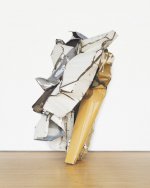Packard
Member
I am in the process of re-facing my kitchen cabinets.
I am building new doors and drawer fronts. I am not concerned about painting those.
However, I am cleaning/filling/priming/painting the face frames which are 1990s era honey oak.
My process so far is as follows:
1. Clean surface with mineral spirts and paper towels.
2. Sand by hand using 120 grit and followed by 220 grit.
3. Clean surfaces again using mineral spirits.
4. Apply a light coat of Seal Coat dewaxed shellac for adhesion.
5. Apply grain filler.
6. Hand sand.
7. Vacuum, wipe down.
8. Apply water based primer. (I have been using 1-2-3 but recently switched to Benjamin Moore’s Fresh Start, tinted to match the top coat.
9. Sand. Vacuum. Wipe.
10. Apply two coats of Advance (hand brushed, undiluted).
I have switched the hinges from 1/2” overlay to 1” overlay, so very little of the face frame is exposed. In theory, I should have been able to go to 1-1/4” overlay, but when I tried that I had interference. Mostly about 1/2” space between doors and 1/4” above and below doors are left exposed.
The grain filler worked well, dried hard and sanded to a powder easily. With so little of the face frame being exposed, I probably could have skipped the grain filler.
Am I missing some steps? Am I doing overkill?
I am replacing the end panels, so only the face frame needs to be refinished.
So far I have 10 linear feet of cabinets completed (uppers and lowers). I have another 20 feet (uppers and lowers) remaining.
I probably should have asked about this before starting.
PS: I’ve been using Park’s grain filler (A Rustoleum company), I get this at Home Depot.
It is designed for filling grain and cracks on wood floors. It comes in colors, but the only one I see is “red oak”. Unlike spackle, it dries rock hard. And unlike lightweight spackle, it sands easily to a powder.
I started using 1-2-3 primer (dark gray) to go under black cabinets. I can’t find the gray anymore, and though the white primer says “tintable”, Neither Lowes or Home Depot will do so.
I am about to start using Benjamin Moore’s “Fresh Start”, tinted to a very dark gray. For reasons that they could not explain, they could not tint to a true black.
I am building new doors and drawer fronts. I am not concerned about painting those.
However, I am cleaning/filling/priming/painting the face frames which are 1990s era honey oak.
My process so far is as follows:
1. Clean surface with mineral spirts and paper towels.
2. Sand by hand using 120 grit and followed by 220 grit.
3. Clean surfaces again using mineral spirits.
4. Apply a light coat of Seal Coat dewaxed shellac for adhesion.
5. Apply grain filler.
6. Hand sand.
7. Vacuum, wipe down.
8. Apply water based primer. (I have been using 1-2-3 but recently switched to Benjamin Moore’s Fresh Start, tinted to match the top coat.
9. Sand. Vacuum. Wipe.
10. Apply two coats of Advance (hand brushed, undiluted).
I have switched the hinges from 1/2” overlay to 1” overlay, so very little of the face frame is exposed. In theory, I should have been able to go to 1-1/4” overlay, but when I tried that I had interference. Mostly about 1/2” space between doors and 1/4” above and below doors are left exposed.
The grain filler worked well, dried hard and sanded to a powder easily. With so little of the face frame being exposed, I probably could have skipped the grain filler.
Am I missing some steps? Am I doing overkill?
I am replacing the end panels, so only the face frame needs to be refinished.
So far I have 10 linear feet of cabinets completed (uppers and lowers). I have another 20 feet (uppers and lowers) remaining.
I probably should have asked about this before starting.
PS: I’ve been using Park’s grain filler (A Rustoleum company), I get this at Home Depot.
It is designed for filling grain and cracks on wood floors. It comes in colors, but the only one I see is “red oak”. Unlike spackle, it dries rock hard. And unlike lightweight spackle, it sands easily to a powder.
I started using 1-2-3 primer (dark gray) to go under black cabinets. I can’t find the gray anymore, and though the white primer says “tintable”, Neither Lowes or Home Depot will do so.
I am about to start using Benjamin Moore’s “Fresh Start”, tinted to a very dark gray. For reasons that they could not explain, they could not tint to a true black.

